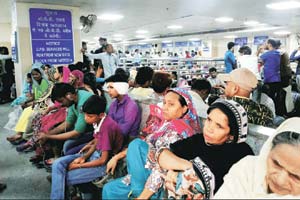There has been a rise in the number of world-class hospitals and highly-qualified medical personnel in India, and the nation’s emergence as a preferred destination for medical tourism has been the cause of much celebration and accolade. However, the not-so-bright side of the picture is that for millions of Indians, healthcare services continue to be out of reach in terms of both access and affordability. India compares poorly to other developing countries on parameters such as hospital-bed density, ratio of physicians-to-population, number of doctors graduating every year, and per capita public expenditure on healthcare.
Consider this. Private healthcare expenditure amounts to around 4% of the GDP, making it one of the highest ranking countries in terms of private expenditure on health. Of this, health insurance accounts for 5-10% of expenditure, employers account for around 9% while personal expenditure amounts to an astounding 82%.
ICE 360 Survey 2014 findings show that the average annual total medical expenditure is about R9,373. For households located in less than 1 million population towns (classified as Other Urban), the expenditure is the highest at R13,198 compared to R11,387 for a Metro household and R6,371 for an Underdeveloped Rural household. In percentage terms, those living in the Other Urban and Underdeveloped Rural areas are spending the highest proportion of their income—5.8% and 5.0%, respectively—on medical expenses.
The reported annual expenditure on health-related expenses ranged from a minimum of a few hundred rupees to a maximum of R10 lakh. Healthcare expenses are on the higher side for Emerging Rural areas and smaller urban towns and often forcing them to travel long distances for accessing the required medical services. Now, the question arises, how do families cope with rising healthcare costs and medical emergencies? Barely 10-15% of the population has some form of insurance coverage. Nearly 80% of health-related expenditure is, therefore, met along with other recurring household expenses.
It’s no surprise then that for nearly 60% households, the primary reason for saving is to enable them to deal with medical emergencies. Nearly 60% of households in Underdeveloped Rural areas and 50% residing in Metro cities identified healthcare-related saving as a major priority. Between 8-9% of households across all households in urban and rural areas reported they had taken loans to meet their medical expenses.
The implications for the financially vulnerable households can be quite devastating in case of any medical emergency. Preventive medicine is practically non-existent among the poor and any illness is only attended to when it reaches a critical stage. Consequently, this leads to a double jeopardy: loss of income during illness as well as major spending on treatment. A majority of the bottom of the pyramid households (40%) reported loss of income during illness. Nearly 22% of Metro financially-vulnerable households reported negative surplus income. Developed Rural’s share of such households is 33%. Therefore, for such households, which are already spending more than they earn on meeting regular needs, a medical emergency would tip them over the financial edge.
What’s worse is that any additional burden on the already high healthcare expenses would tip a large proportion of Indian households into the financially-vulnerable category. Therefore, the all-India share of 30% vulnerable households (or those with negative surplus income) rises to almost 86% in case of an additional burden of R1 lakh towards medical expenses.
It’s small wonder then that meeting healthcare expenses continues to be one of the major concerns for households.
When chief wage earners were asked about what worries them the most, nearly half of all respondents across all locations (ranging from Metros to Underdeveloped Rural) gave top priority to “personal and family health” above other issues such as losing/not finding a job; not being able to provide education to children; poor infrastructure; or meeting expenses for daughter’s wedding. Nearly 46% cited healthcare as a major concern. The other worry that shared the top spot was safety and security (46%). Only 34% households in India reported that they can “easily” meet their medical expenses. More than half of metro households (53%) fall in this category. Significantly, nearly half of Indian households confess that they meet their medical expense with “some difficulty” and 14% reported that had “great difficulty” in doing so.
On another note, when asked their opinion about what the government should prioritise on during the next decade, a large majority of chief wage earners said “better health”. The healthcare scenario, thus, calls for urgent intervention. While private health insurance coverage is on the rise, this system is far from efficient to meet the needs of diverse population segments. The absence of a comprehensive health insurance is pushing already vulnerable households below the poverty line.
The key issue is: when a large majority of population is feeling overwhelmed by the cost of healthcare, should it be left to the supermarkets to promote healthy living and create systems where medical services can be attained in a timely and cost-effective manner? Or do policy-makers need to look at “healthcare” as a key element of the economic well-being of the country?
The author is director & CEO, People Research on India’s Consumer Economy (ICE 360°)


